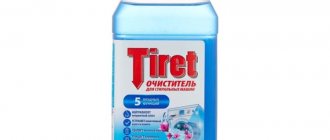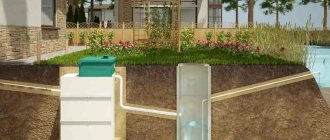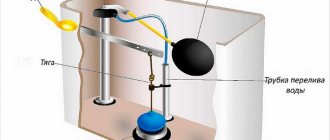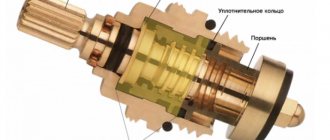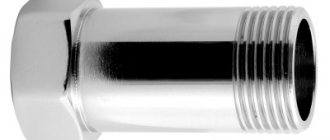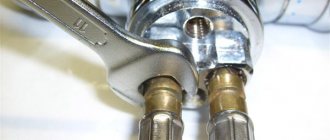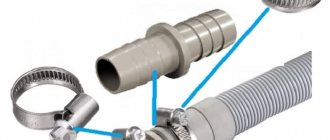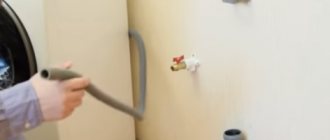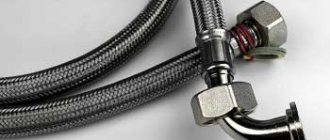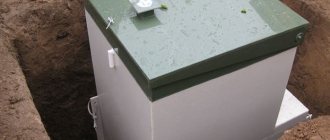Installing a washing machine in your home includes connecting it not only to the electrical network and water supply, but also to the sewer system. Moreover, it is with drainage that difficulties often arise; connecting the household appliances in question to the power supply and water is as easy as shelling pears. To connect the washing machine to the sewer yourself, you can use three methods. The technology in all cases is extremely simple. Any self-taught person can do everything, you just need to follow the simplest rules.
Necessary tools and components
To connect the washing machine to the sewer, you need to have three tools on hand:
- Pliers.
- Flathead screwdriver.
- Pipe cutter for plastic pipes (or hacksaw for metal).
Wrenches may only be needed if it is necessary to extend an existing drain hose using a coupling. This will have to be done when the automatic machine is far from the sewer outlet. At the same time, it is highly not recommended to extend this flexible drain outlet to a length of more than three meters. If it is long, the pump in the washing machine may not be able to cope with pumping water and burn out.
Necessary adapters and taps for connecting a washing machine
Consumables you will need:
To connect the washing machine drain to the sewer, a minimum set of tools and components is sufficient. The same replacement of electrical wiring or installation of water pipes requires much more tools.
Washing machine connection diagram
Cost of connecting a washing machine to the sewer
| List of works | Materials (included in price) |
|
|
Methods
Connecting the washing machine to the sewer system is done:
- directly to the sewer pipe using a tee;
- through a connection to the siphon under the sink.
The first option is more difficult to implement with your own hands, but it is more practical and reliable. Plus, the risk of flooding when connected to a siphon is much higher than in the case of a direct connection between the drain hose and the sewer pipe.
Necessary conditions for connecting a washing machine to a siphon
At the same time, it is recommended to choose a method even when the question of how to install a sewer system in a house or apartment is being decided. It is better to determine in advance the location for the washing machine. And it is also necessary to provide in advance for this equipment an insertion point in the sewer system.
Another way to organize drainage from a washing machine is to simply hang the hose on the side of the toilet or bathtub. In this case, even installation tools are not required. But it’s difficult to call this option correct. Plus, you will have to look after such water flow more carefully in order to definitely avoid a flood in the house.
Connecting a washing machine
Connection via siphon
It is possible to connect the washing machine to the sewer system using a drain siphon only if it is designed for such installation. If it doesn't have a side outlet for connecting an additional hose, then nothing will work. Or he will come to change it to the desired option.
How to connect a washing machine via a siphon
Moreover, if the cabinet under the sink is small in size or the washbasin is on a narrow ceramic leg, then draining through a siphon with a pipe on the side will not work. There simply won't be enough space under the bowl for new pipes.
Rules for installing a washing machine under the sink
The connection is made via a siphon as follows:
- The plug is removed from the side pipe.
- It is lubricated with silicone.
- A hose from a washing machine is put on the outlet, over which a worm-drive clamp is pulled.
- The clamp is tightened with a screwdriver or pliers.
How to connect a washing machine to the sewer and water supply in the kitchen
The main disadvantage of this method is gurgling in the sink drain when the washing machine is running.
Using reduction directly to the sewer
To connect the washing machine directly to the sewer, you need to install a tee on the drain pipe under the sink or bathtub. One of its outlets will be used in the old way for connected plumbing, and the second will be used for the washing machine. You can also make a tie-in directly into the sewer pipeline or mount a branch from the riser. But these options are more complex; you should resort to them only when carrying out major repairs.
How to properly install a washing machine
The drain from the machine is inserted into the tee through a rubber collar. This adapter has to be used, since hoses from washing machines and plastic fittings, PVC sewer pipes for internal sewerage have different diameters. If you simply insert the drain outlet into the tee, then the drainage under pressure will flow out of the pipeline through the gap at the junction.
Connecting the washing machine drain
To start
Remember two main rules that must be followed before any repair work on household appliances.
Shut off the water
Close the water supply shut-off valves. They are usually located behind the washing machine on pipes. Now, even if the hose is damaged during operation, water will not flow.
De-energize
Remove the plug from the socket. To keep the wire out of the way, you can attach it with paper tape or wire to the back wall of the washing machine.
Preparing tools and materials
Before you begin repairing, replacing, or extending the drain hose, make sure you have everything you need on hand:
- pliers;
- screwdrivers;
- fastenings - metal clamp, coupling or adapter;
- sealant, we recommend using silicone;
- water for washing and cleaning;
- brush or cable;
- the spare parts themselves.
Other draining methods
You can also drain the water from the washing machine directly into the bathtub, sink or toilet. To do this, almost all of the household appliances under consideration are supplied with a hard plastic nozzle for the drainage hose. It is designed to fix the drain hose on the side of the above-mentioned plumbing fixtures.
Installation and installation of washing machine drain
The main advantage of this connection is simplicity. However, the plumbing fixtures will have to be washed after each automatic wash, since the water from the washing machine that goes down the drain is by no means crystal clear. Plus, due to the high pressure, some of the drainage can spill out of the sink or toilet onto the floor. Then you will have to clean the entire bathroom.
Step-by-step instruction
Most often, the length of the drain hose reaches about two meters. But on average it is 1.5 m. If your machine is installed in such a way that the standard size is not enough, you can increase the tube or buy another one in a specialized store.
Lengthen standard
The easiest way to extend a drain hose is to attach another one to the existing one. For example, from an old typewriter. Or buy a new one. Moreover, there are at least two ways to lengthen it.
For the first you will need a special plastic adapter (coupling):
- Place the ends of the parts onto the connector.
- Tighten the clamps on both sides.
- Run a test wash.
- If water leaks at the connection, tighten the clamps more tightly and apply silicone sealant.
For the second method, you need a piece of plastic or rubber tube with a diameter slightly smaller than the diameter of the hoses. Their ends must be put on this improvised extension cord and aligned. The connection must be tight. Place the clamps on top and tighten tightly. Run the wash and check the tightness.
Put a new one
If you are not sure that the extended hose will be leak-proof and will last a long time, it is better to buy a new one of the right size.
To replace it, you will have to disassemble the body of the washing machine.
A drain tube is attached to the pump to drain dirty water. This is where you need to get.
Universal instructions for disassembling washing machines: 23 videos for all brands
Depending on the brand of the washing machine, the pump can be located anywhere: bottom, side, back. Therefore, before repair work, carefully read the universal instructions located above.
First of all, use a screwdriver to unscrew all the fasteners and open access to the pump. If it is uncomfortable to work with, place the machine on its side. Make sure that the electronic control module is at the top.
Further:
- If there is any remaining water in the drain tube, drain it. You can put a rag or a basin under the pump.
- Remove the fasteners from the part of the siphon to which the pipe is connected.
- If a check valve is installed on the drain, unscrew it.
- Use a flathead screwdriver to loosen the bolts on the pump and pipes.
- Remove the drain pump.
- Use pliers to loosen the clamp and disconnect the hose.
- Carefully remove it.
- Attach the new tube to the pump.
- Replace the pump.
- Connect the drainage tube to the drain (sewer, siphon or check valve).
- Reattach the external/internal bolts, fasteners and clamps.
Selecting a location
In this case, the determining role is played by the distance from the sewer to the washing machine. Within a standard city apartment or private house, it is most often placed in the bathroom, sometimes in the kitchen.
In the kitchen, drainage is usually organized through a tie-in or siphon, regardless of the distance to the communications. Drainage over the edge of the sink is unacceptable here for sanitary reasons.
In the bathroom, the choice is much wider:
- instead of a washbasin;
- next to the bathroom opposite the sewer line;
- next to the sink or toilet.
In all options, the drain can be connected in several ways, which are described in the table.
| Placement | Optimal drainage methods |
| Instead of a washbasin | Through a siphon or tap |
| Next to the bathroom opposite the sewer line | Over the edge of the bath |
| Near the sink or toilet | Through a cut-in or siphon As an additional and least expensive option - through the edge of the sink or toilet |
Why change the drain hose?
The part is changed in several cases:
- The corrugated part of the tube is damaged and there is a leak;
- A lot of debris has accumulated inside, it is not possible to clean it;
- The length of the original spare part included with the machine is not suitable, it is too short or long for the room in which the device is installed.
Repairing the tube if damaged or trying to clear the blockage actually makes no sense. The surface of the part is sealed. If a leak develops, it will not be possible to close it securely. Sooner or later, under the influence of water and household chemicals, it will appear again. The cost of hoses is low, on average they cost 100-150 rubles, replacement is easy.
If the leak is within the pipe, and at the place where the hose is attached to the sewer, it is better to call a plumber. Reliable fastening to the sewer drain is necessary so that in the room where the machine is installed there are no puddles from a leaky joint.
Connection to water supply
Water supply hose
In this case, oddly enough, connecting the unit to the water supply is much easier than to the sewer, since here, in fact, there is no choice. In any case, the water supply pipeline must be located near the automatic machine and there must be shut-off valves in the form of a straight or corner valve. There are two clamping nuts on the hose itself, therefore, there must be a fitting with an external thread on the machine itself and on the shut-off valve.
Connection to water supply shut-off valves
It is noteworthy that the nuts are designed for a 3/4-inch diameter, therefore, the shut-off valves must have the exact same thread. But if a special tap that is designed for this purpose is made at 3/4, then the water supply wiring most often has 1/2 inch. Therefore, in some cases a reducing fitting will be required for connection.
Are adapters needed for sewer pipes?
Setting up the drain of a washing machine or sink does not require the installation of additional adapters. Moreover, all internal sewer wiring is carried out with components of the same diameter - for convenient operation and repair. Additional elements, fittings, angles, tees and crosses, also repeat the same size. Manufacturers of automatic machines take into account existing housing standards and produce equipment that meets them.
Modern washing machines are connected to the sewer without adapters.
The only exception would be the toilet. For obvious reasons, it is connected to larger diameter pipes to minimize the likelihood of blockages. Thus, the outlet is mounted in a 110 mm tee, commensurate with the sewer riser. Afterwards, an adapter with dimensions of 100x50 is fixed, and then standard wiring follows.
To connect a washing machine to the sewer, you only need an adapter rubber cuff of the following sizes:
- internal diameter – commensurate with the inlet part of the machine’s drain hose;
- external - equal to the circumference of the bell.
If drainage is established through the washbasin siphon, then an adapter rubber band is not required. The corrugation is securely fixed in the socket angle or tee, where the sealing ring is already located. The last element ensures the necessary tightness.
Internal sewerage distribution is carried out with pipes of the same diameter, which simplifies the connection and operation of household appliances.
Features of connecting a washing machine
Correct bend of the drain hose
First of all, you should know if your washing machine has a check valve on the drain that only allows water to flow in one direction. Only in this case will you be able to figure out how to properly connect the washing machine to the sewer.
If such a device does not exist, then the manufacturer must indicate the height level at which the hose loop should be located - a water seal is created in this area. This seal mainly serves to prevent the leakage of unpleasant odors that may come from the drain pipe through the machine.
Features and connection principle
The water from the automatic washing machine (WMA) is discharged into the sewer (or into a septic tank at the dacha). For this, a pipe or corrugated round section of smaller diameter is used, connected either directly to a common sewer pipe using a tee, or through a siphon (elbow) under the sink, which protects the air in the room from odors from the drain line.
The drain line of the washing machine is located below the inlet (water supply) - this allows the suction and exhaust pumps to spend less energy on drawing fresh water and draining waste water - and also work longer without breakdowns.
